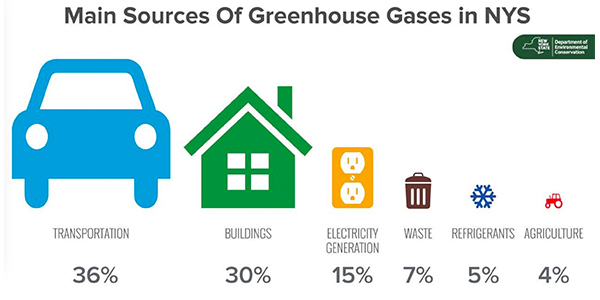New York officials on Monday held the first of three public hearings as they prepare the first annual report of statewide greenhouse gas emissions required by the state’s Climate Leadership and Community Protection Act (CLCPA).
The state Department of Environmental Conservation (DEC) is preparing the report to be issued this year and is seeking public input on its format and the methodology used to determine annual statewide GHG emission levels.
“There is no deadline at all for public input, but if you really want to inform the annual report you should get it in by May,” Suzanne Hagell, climate change policy analyst at the DEC’s Office of Climate Change, said. A second hearing on Friday will cover oil and gas emissions accounting, and the third hearing on Monday will cover net emissions accounting.
The CLCPA mandates that GHG emissions be reduced to 40% of 1990 levels by 2030 and 85% by 2050. It directs the DEC to measure emissions on a common scale using the carbon dioxide equivalence metric and the 20-year global warming potential of each gas, as derived from the U.N.’s Intergovernmental Panel on Climate Change.
The DEC in October completed its public hearing process on the (Part 496) emissions limits and in December finalized the regulations to reduce GHG emissions, the first regulatory requirement of the climate law. (See New York Holds Final CLCPA Emissions Hearings.)
EPA Model
The department is basing its report on the EPA draft Inventory of U.S. Greenhouse Gas Emissions and Sinks from 1990-2019, the final version of which will be published in April.
Inventorying manufacturing emissions would depend on their type, which may be confusing for industries with emissions that go under different categories, Hagell said. For example, CO2 emitted from a foundry would fall under the category of “industrial process and product use,” while emissions associated with combustion of fuel to drive or energize the process would go under “energy.” “I’d love input on how the EPA takes these emissions and categorizes them in different ways to present them for a different purpose, like for economic sectors as opposed to emissions sectors,” she said. “If there is something that is particularly helpful for New York state, a different way of organizing, we can always organize in multiple ways and provide figures in this report that would be helpful for the purpose of policy.”
Officials can evaluate whether to include the social cost of carbon in the GHG emissions report, though they are not aware of any other jurisdiction doing so, she said. Also, emissions data will not be reported at the county level, as such data is not always reported at a granular level and a hydrofluorocarbon inventory is not yet available.
The state is working to cut GHG emissions (including methane and hydrofluorocarbons) from buildings, food waste and other sources outside the power and transportation sectors, and data in the report will reflect that goal. (See NY Proposes Food Scrap Regs to Cut Waste, Emissions.)
In addition, the state plans to collect data on non-GHG emissions, such as particulate matter (PM2.5).
“We do calculate emissions from heating fuel use as well as from a host of other categories, and several pollutants from each,” Ona Papageorgiou, DEC chief of mobile source and climate change planning, said. “There are criteria pollutants as well as some others that may be included, and PM2.5 is part of that.”
Feedback may be provided at any time and can be mailed to DEC Office of Climate Change, 625 Broadway, Albany, NY 12233-1550 or emailed to [email protected] Include “Annual Report” in the subject line of the email.



